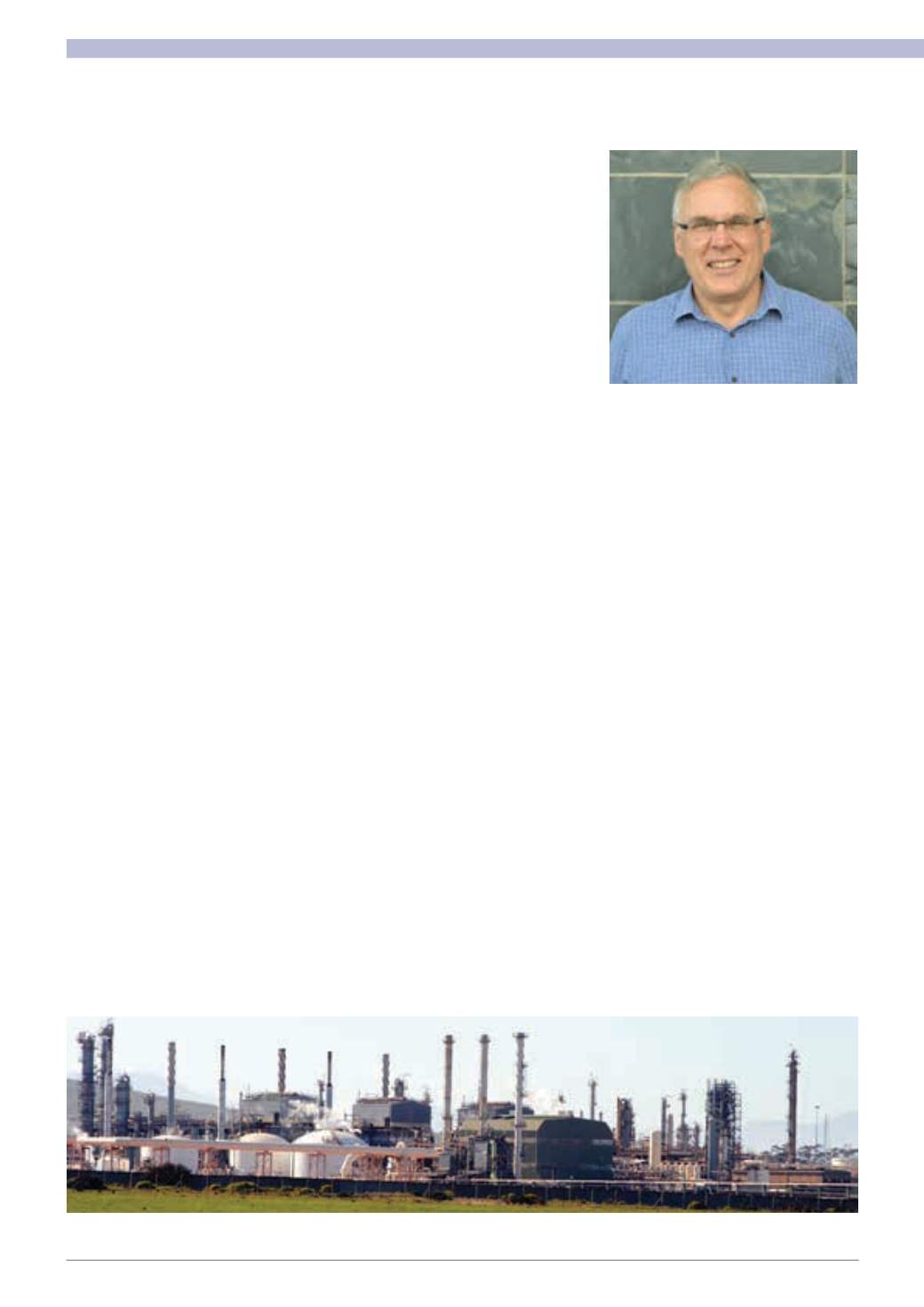

6
¦
MechChem Africa
•
April 2017
A
lanCousinswas born andeducated
inZimbabwe.“IcompletedA-Levels
in Zimbabwe in 1979 in pure and
applied mathematics, physics and
chemistry. Then Iwas in the last call-up for na-
tional service andwas commissioned into the
newZimbabweanarmy, where I spentmost of
my time gettingmy colleagues releasedearly,”
he tells
MechChem Africa
.
“After completing national service, I
wanted to go overseas to study in the UK,
but it was just at that time that Margaret
Thatcher pulled the funding plug on overseas
students and I couldn’t afford it,” he con-
tinues. “So I applied for and was awarded a
Union Corporation bursary to come down to
University of Cape Town to study Chemical
Engineering.
“I came to South Africa in 1981 and
graduatedattheend1984.Ataboutthattime,
Union Corporation merged with the General
Mining and Finance Corporation to become
Gencor. On completion ofmy studies, I joined
Gencor as part of my bursary obligation and
ended up going to Impala Platinum’s precious
metalrefineryinSprings,whereIworkedfrom
1985 to 1987,” he reveals.
For a young graduate interested in chemi-
cal processes, “this was a good place to be”.
The options for a young chemical engineer in
a mining company at that time were gold or
PGMs (platinum group metals) and “I wasn’t
too impressedwith the chemical engineering
involved ingoldprocessing,” Cousins explains.
“The Springs precious metal refinery was
a placewith an intense chemical engineering
focus at that time. A whole chain of extrac-
tion processes was being used to separate
out the different metals, including solvent
extraction; inorganic leaching; ion exchange;
and calcining. The refining processes were
muchmore chemical extraction focused than
those used for gold,” he explains.
“PGMs are really hard to ionise, but when
theydo, they formsome amazing compounds.
Iron has Fe
2+
and Fe
3+
ionisation states, but
PGM metals can form ions with a charge of
2+, 3+, 4+ or 5+. These all form different
complex salts, so the R&D side is fascinating,”
says Cousins.
“In those days, PGM extraction was fairly
primitive, involving Aqua Regia leaching, salt
precipitation and the emission of significant
amounts of sulphurous and nitrous oxides
(SOx and NOx),
Outlining the process used, Cousins says
that mined PGM ore is first concentrated
by flotation and then converted in furnaces
to a form that can be leached. The resulting
metal, called matte, consists of a mixture of
platinium, palladium, rhodium, ruthenium
and iridium (the PGMs) but it also comeswith
nickel, copper and small quantities of gold.
“At the first stage, a high temperature acid
pressure leach processwas used to preferen-
tially dissolve the copper and the nickel from
the PGM Group metals. This dissolved leach
then went for further processing – electro
winning – to extract the copper followed by
precipitation to recover the nickel.
“The residue from the pressure leach
process, a dark grey sludge, was placed into
an Aqua Regia leach, a mix of nitric and hy-
drochloric acid, named because of its ability
to dissolve gold. Aqua Regia, which was used
to preferentially dissolve out the platinium
and palladium, is associated with some very
toxic fumes, though,” Cousins says.
“From this leach, complex platinum and
palladium salts were precipitated, which are
particularly allergenic. I only ended up on
the platinum side of this process because I
survived all the allergy tests during my medi-
cal,” he notes.
MechChemAfrica talks to Alan Cousins, who has been member of SAIChE for over
30 years and, for the past ten years, the chemical profession’s representative on
the professional advisory committee (PAC) for ECSA.
Chem Eng
and the bigger picture
Once the platinum and palladium were
pulled out, the remaining PGMs – rhodium,
ruthenium and iridium – were extracted, via
a combination of ion exchange and solvent
extraction principles, “but therewere not yet
mature markets for these metals,” he adds.
All the individually precipitated salts then
hadtogothroughcalciningfurnacestoreduce
the metal ions into pure precious metals.
“This processwas not sustainable, though,
from the environmental side, owing to SOx
and NOx fumes and, because the salts were
allergenic, many of the employees involved
became allergic causing staff turnover to be
unsustainably high,” Cousins points out.
During his third year at Gencor, Cousins
moved into the project environment to ad-
dress the inadequacies of the Springs extrac-
tionprocesses anddoing the front-enddesign
of a new platinum refinery.
“What this gave me was the basis for the
rest of my career. The department was run
on an EPC basis and the manager, Grenville
Dunne, used multi-disciplinary task teams,
including all the engineering disciplines,
project engineers and process engineers,”
Cousins recalls.
“Iwasinvolvedinbig-picturedevelopment:
calculating mass, heat and energy balances;
preparing process flow diagrams (PFDs) and
piping and instrumentation (P&I) diagrams;
and designing process equipment. It was
great exposure to awide rangeof engineering
tasks,” he tells
MechChem Africa
.
In 1987, Cousins moved to Fluor in Sandton, Johannesburg, to a join a team involved in the early development of PetroSA’s Mossgas refinery.
















